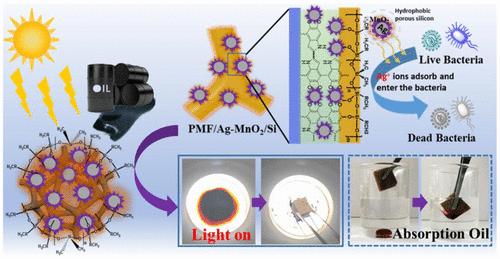Multifunctional Superhydrophobic Sponge In Situ Anchoring of Ag-MnO2 via Polydopamine Activation for Efficient Oil–Water Separation, Photothermal Conversion and Antibacterial Applications
IF 8.2
2区 材料科学
Q1 MATERIALS SCIENCE, MULTIDISCIPLINARY
引用次数: 0
Abstract
Frequent oil spills and the discharge of oily wastewater pose serious threats to the environment, ecosystems, and humans. Herein, a multifunctional superhydrophobic sponge was successfully prepared through the in situ growth of Ag-MnO2 nanoparticles assisted by polydopamine rapid deposition and subsequent hydrophobic silicon modification. Owing to the synergistic effects of the hierarchical micro/nanostructure and methyl-terminated surface modification, the obtained superhydrophobic sponge has a water contact angle (WCA) of 156.5°, demonstrating excellent chemical stability and structural durability under harsh environmental media and mechanical damage. For oil–water separation, the adsorption capacity of modified sponge for various oils ranges from 58.2 to 132.6 times its own weight and great separation efficiency up to 98.38%. Through the photothermal conversion effect of Ag-MnO2 nanocomposite, the surface temperature of the material can reach 64.1 °C under simulated radiation, achieving rapid adsorption and recovery of high-viscosity oil. Additionally, the immobilization of silver nanoparticles within the sponge skeleton effectively inhibits the growth of Escherichia coli and Staphylococcus aureus, exhibiting antibacterial properties that facilitate the elimination of bacteria in organically contaminated water sources. Therefore, the multifunctional superhydrophobic sponge in this study provides high potential and efficient application for efficient oil–water separation, rapid crude oil recovery, and antibacterial pollution of water.

聚多巴胺活化的多功能超疏水海绵原位锚定Ag-MnO2用于高效油水分离、光热转化和抗菌应用
频繁的石油泄漏和含油废水的排放对环境、生态系统和人类构成了严重的威胁。本文通过原位生长Ag-MnO2纳米颗粒,并辅以聚多巴胺快速沉积和疏水硅修饰,成功制备了多功能超疏水海绵。由于分层微纳米结构和端甲基表面修饰的协同作用,制备的超疏水海绵具有156.5°的水接触角(WCA),在恶劣环境介质和机械损伤下表现出优异的化学稳定性和结构耐久性。在油水分离方面,改性海绵对各种油类的吸附量为其自重的58.2 ~ 132.6倍,分离效率高达98.38%。通过Ag-MnO2纳米复合材料的光热转化效应,材料在模拟辐射下的表面温度可达到64.1℃,实现了对高粘度油的快速吸附和回收。此外,将纳米银颗粒固定在海绵骨架内,可以有效抑制大肠杆菌和金黄色葡萄球菌的生长,表现出抗菌特性,有助于消除有机污染水源中的细菌。因此,本研究的多功能超疏水海绵在油水高效分离、原油快速回收、水体抗菌污染等方面具有很高的应用潜力。
本文章由计算机程序翻译,如有差异,请以英文原文为准。
求助全文
约1分钟内获得全文
求助全文
来源期刊

ACS Applied Materials & Interfaces
工程技术-材料科学:综合
CiteScore
16.00
自引率
6.30%
发文量
4978
审稿时长
1.8 months
期刊介绍:
ACS Applied Materials & Interfaces is a leading interdisciplinary journal that brings together chemists, engineers, physicists, and biologists to explore the development and utilization of newly-discovered materials and interfacial processes for specific applications. Our journal has experienced remarkable growth since its establishment in 2009, both in terms of the number of articles published and the impact of the research showcased. We are proud to foster a truly global community, with the majority of published articles originating from outside the United States, reflecting the rapid growth of applied research worldwide.
 求助内容:
求助内容: 应助结果提醒方式:
应助结果提醒方式:


